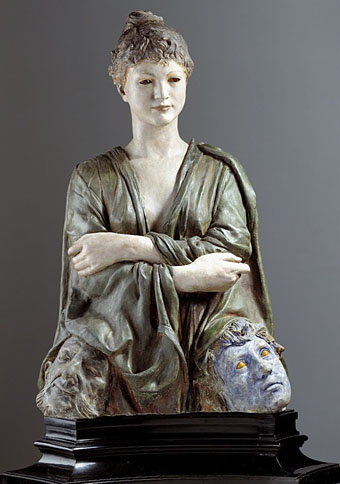The New Salomé (1887–1888) by Max Klinger.
The German Symbolist Max Klinger (1857–1920) is celebrated today for the etchings which comprise his Ein Handschuh (A Glove) series, ten prints that in their curious details and dream-like quality prefigure Surrealism and Giorgio de Chirico’s “metaphysical” paintings. During his life Klinger was highly regarded for his sculpture as well as his etchings: his Beethoven was a centrepiece of the Secession building in Vienna in 1902. His New Salomé is one of the handful of Klinger works at the Google Art Project where I still feel we ought to be able to view sculpture in the round. I’ve seen many photos of this piece before but hadn’t realised until now that the eyes were…what? Rubies? Amber? Whatever they are, their fiery cast ensures that his imperious female sits unequivocally with the Evil Women that proliferated in the late 19th century.
Salomé (c.1910) by Julio Borrell Pla.
Klinger’s sculpture may have been fashionably misogynist but it was at least a serious piece of art. Twenty years later the Salomé theme had devolved to little more than titillating exotica, as with this vaporous painting by Julio Borrell Pla which I hadn’t come across before. The last gasp of this exhausted trend is William Dieterle’s 1953 film in which Rita Hayworth plays Herod’s daughter as all titillation and little else.
Elsewhere on { feuilleton }
• The Salomé archive



And of course ‘King of Kings’ http://www.youtube.com/watch?v=1bzSD79Z9yk
I don’t think I’ve ever watched that one all the way through so that scene was news to me. At least she’s younger: Rita Hayworth was 35 when she played Salomé which stretches credulity for all sorts of reasons.
Not exactly what I’ve been fixated upon musically as of late, though my long absense from the ‘style’ has not in any way cooled my admirations, but I’ve long thought the Hans Bellmer doll cover, and later even the superior (in my humble opinion) Suehiro Marou cover, though relatable, did not truly do music of the album ‘Absinthe’ by Naked City the justice it deserved. Being as it, while certainly not John Zorn’s only venture into subtle ambient atmospherics, is Naked City’s only such venture, and is in my opinion one of the eeriest ambient albums out there, I felt it deserved better aesthetic representation. The ‘glove’ series by Klinger would have been one of my first choices. I am sure Zorn & co. would have at least been intrigued by such a proposal when the album was first released since in all of his more recent endeavors he has featured extraordinarily inventive album artwork, much of which falls within the strange symbolist terrain.